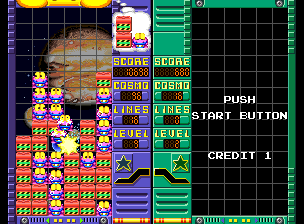Cosmo Gang the Puzzle
| Cosmo Gang: The Puzzle | |
|---|---|
|
Screenshot | |
| Developer(s) | Namco |
| Publisher(s) | Namco |
| Designer(s) | Kohji Kenjoh |
| Composer(s) | Yoshie Arakawa |
| Platform(s) | Arcade, Super Famicom/SNES, Virtual Console |
| Release date(s) |
Arcade
Super Famicom/SNES
Wii Virtual Console
Arcade‹See Tfd›
Wii U Virtual Console
|
| Genre(s) | Puzzle |
| Mode(s) | 2 players can play simultaneously |
| Cabinet | Upright, cabaret, and cocktail |
| Arcade system | Namco NA-1 |
| CPU |
1x Motorola 68000 @ 12.5 MHz, 1x Motorola M37702 @ 12.5 MHz |
| Sound | 1x C140 @ 44.1 kHz |
| Display | Horizontal orientation, Raster, 304 x 224 resolution |
Cosmo Gang: The Puzzle (コズモギャング・ザ・パズル Kozumo Gyangu: Za Pazuru) is an arcade game that was released by Namco in 1992; it runs on Namco NA-1 hardware, and as the title suggests, is the sequel to Cosmo Gang: The Video, which was released in the previous year (which, in turn, was based on the 1990 redemption game Cosmo Gang). An adaptation of the game featuring Pac-Man characters was released in 1993 called Pac-Attack (Pac-Man himself took on the role of the balls, while an infinite amount of Blinky and Sue clones took on the roles of the Cosmo Gangers, an infinite amount of gold bricks took the role of the Containers, and Fairies took the role of the Stars). As with its predecessor, a SNES version was released the following year, and this version would be re-released on the Wii Virtual Console; however, both the original game and its Virtual Console re-release are Japan-only.
Gameplay
The players must stack the falling Jammers from the original game (or a new type of Cosmo Gangers called "Pipopapo-Tai"[1]) and Containers into groups by using their joysticks to move pieces left, right and down and pressing their buttons to rotate them; when a player fills a line of Containers, they will disappear. When a ball appears, note which direction the arrow on it is facing, as it will move in that direction when it drops - and it shall eliminate any Cosmo Gangers it hits on its way down to the bottom of the screen. If a player has chosen to start the game on "Normal", "Hard" or "Expert" difficulty level, their "Star Meter" will fill up every time a ball eliminates a Cosmo Ganger; once it's completely filled, a Star will fall down from the top of the screen and eliminate seven rows of Cosmo Gangers when it lands. The two-player mode can, like The Return of Ishtar, all six of the World Stadium games, its predecessor, and F/A, be played with one credit - and in that mode, not only will eliminating a lot of the Cosmo Gangers at once result in a higher score but it can also cause a group of the eliminating player's Cosmo Gangers to fall down on his opponent's side of the screen. As with other falling puzzle games, the game will be over once the pieces reach the top of the screen; this is also the first game from Namco to not have an ending since Dig Dug II in 1985, which means that the closest a player can get to winning it is by getting 9,999,999 points, eliminating 9,999 Cosmo Gangers, clearing 9,999 lines, reaching level 999, or (for two-player mode) winning 99 times.
